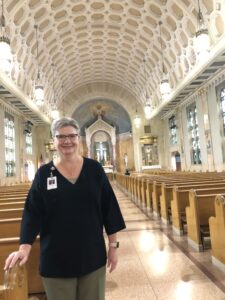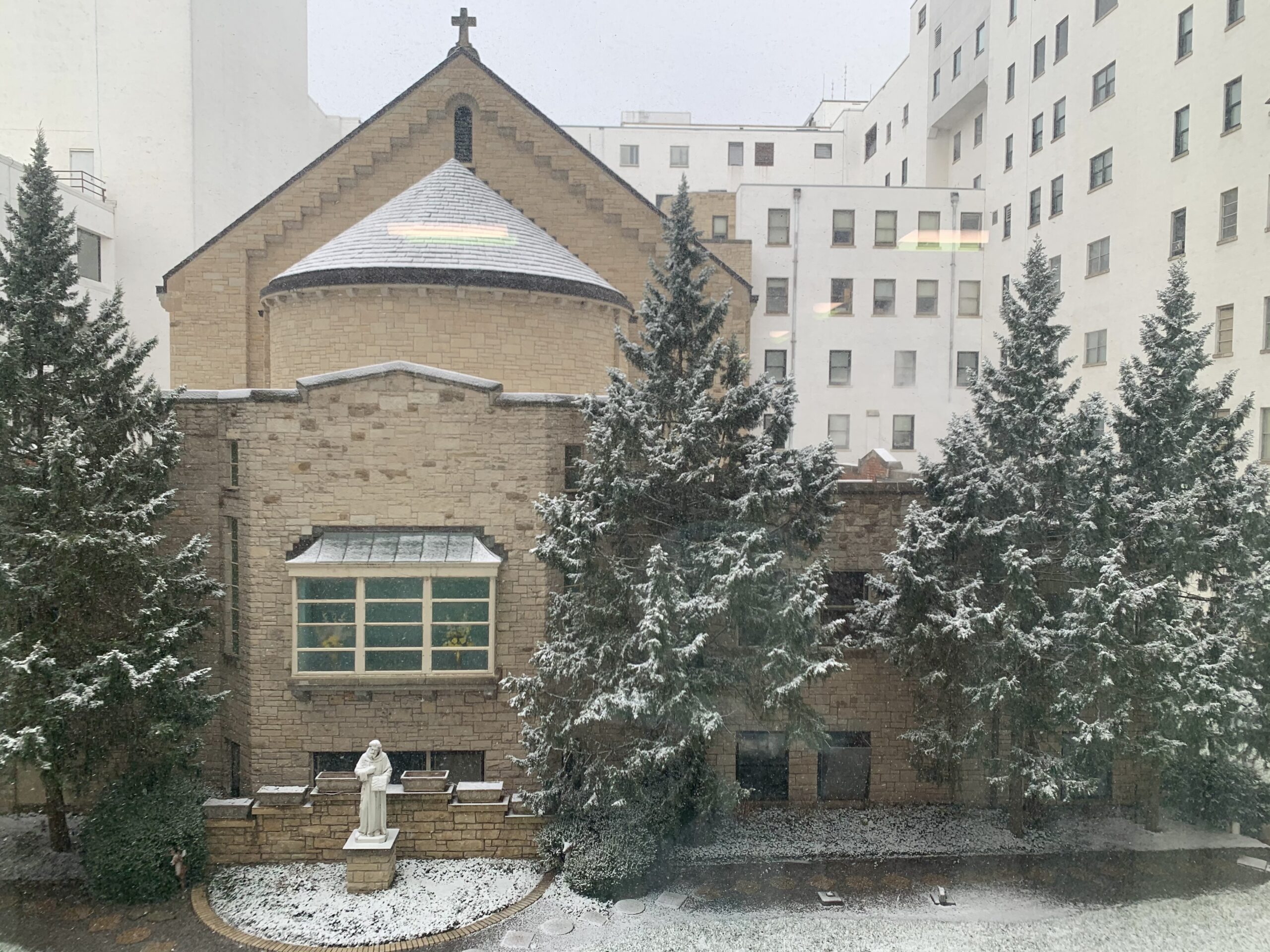There’s a reason why going from point A to point B in Ascension Via Christi St. Francis hospital can seem like a circuitous process: the Chapel of the Sisters of the Sorrowful Mother, which the hospital grew up and around over the decades.
“The Sisters were so stubborn, they just refused to demolish the chapel,” joked Roz Hutchinson, marketing and communications manager for Ascension Kansas.
“I like to think of it as the heart of the hospital,” added Tracey Biles, chief mission integration officer for Ascension Kansas.
The size and impressive features of the chapel tend to take first-time visitors by surprise. As one blogger wrote, she’d always assumed the hospital was a “large cubic mass” until seeing a sign in a hallway for the chapel and discovering it was a standalone structure completely surrounded by wings of the hospital. “One can easily forget one is in a hospital, and the generic (chapel) sign outside seems ludicrously inadequate as an indicator of what’s in here,” she wrote.
“It’s unusual to have a chapel that’s basically the size of a cathedral in the center of your medical center,” Hutchinson said.
The chapel was dedicated on Oct. 15, 1947, at a ceremony attended by more than 300 priests, nuns and members of the Catholic laity, according to an article in the Wichita Eagle. Bishop Mark K. Carroll left his sick bed to bless the edifice, describing it as “the most beautiful chapel in America.” While he might have been biased, there’s no doubt that great care and expense went into it.

Tracy Biles says the size and architectural features of the Chapel of the Sisters of the Sorrowful Mother surprise many visitors.
In a 24-page commemorative issue of the Advance Register, the local diocese’s newspaper, the chapel was described in detail. The main entrance was then on Emporia, through a garden for patients. Otherwise, the chapel has changed relatively little through the years. The rough stone exterior, with arched windows and doorways and a tower, recalls the Romanesque style of Italy in the Middle Ages; the stone was imported from Wisconsin.
Inside, the walls and vaulted ceiling combine several strains of Travertine marble and plaster. The nave, or main seating area, has no columns to obstruct views of the sanctuary, which features a bronze alter, statues, carved symbols and inscriptions and more marble. Stained glass windows let in daylight, and mosaics depicting the stations of the cross line the walls. A niche holds a statue of Saint Francis, patron of the hospital.
With about 9,300 square feet, the chapel holds 50 pews, enough to seat 500 people. A choir loft contains a pipe organ and more pews. The chapel bell was moved from the previous chapel, where it had been in use for 41 years.
The chapel was called the “pride of the Order” of the Sisters of the Sorrowful Mother, a Rome-based order which had taken over the operations of St. Francis 58 years earlier. According to “A Tradition of Caring 1889-1989” by Hal K. Rothman, “In 1947, the entire administration of the hospital included only one person — the sister Superior, Sister M. Oswaldina Nutz. She conducted the business of the hospital out of one room measuring approximately 12 by 10 ft. and kept all the papers of the institution in one cabinet. The Board of Directors consisted of five other Sisters, Dr. V. Dean Schwartz remember, ‘and no one ever knew who they were. They held their meetings when Sister Oswaldina decided it was necessary — which was not very often. Sisters held every supervisory post in the institution. Every nursing floor had a Sister as a supervisor.’”
The chapel was only part of an ambitious hospital expansion undertaken by the Sisters. The Advance Register noted that the hospital had been overcrowded for several years due to the influx of aviation workers during World War II. In 1936, for instance, the hospital had admitted 5,697 patients. In 1946, the number was 15,496. The improvements included new X-ray, obstetrical and operating departments along with a larger convent, new bakery, kitchen, laundry, powerhouse, cafeteria and dining room for nurses. The chapel also served Catholic nurses and other hospital personnel. Enrollment in the hospital’s School of Nursing was 140, and the Sisters were eager to recruit more.
By the 1950s, the hospital was in the shape of a U, with the chapel at the opening. Eventually, it was completely surrounded by erection of the hospital’s south tower in 1979.
In 1965, a mosaic adorning the dome over the main altar was completed with money donated by medical staff. A modern audio-visual system was installed, allowing services to be live streamed. Entrance is now made on the hospital’s mezzanine level. Last fall, a courtyard outside the chapel was added for use by hospital employees, visitors and patients.
The chapel’s mission has changed in one significant respect. After merging with St. Joseph Hospital to form Via Christi Health in 1995, the Sisters of the Sorrowful Mother eventually turned over operation of the hospital to St. Louis-based Ascension Health, a Catholic nonprofit health system.
But the chapel they built is still active. The hospital operates it under contract with the diocese, employing two priests, Fathers Matt Marney and Ken Schuckman. Masses are held daily, and a physician, Dr. Bassem Rouphael, often plays the organ. The altar will be decorated with a nativity scene for the Advent season, a “longest night” service will be held Dec. 21 and another on Christmas Eve.
Biles said it’s common for visitors to see the chapel from one of the hospital’s rooms and find their way to it. “They’ll come to mass or just come down for some quiet prayer.”
One of Hutchinson’s favorite nightime views of the chapel is from the hospital’s second-floor infusion therapy center, where cancer patients and others are treated. “Just having those beautiful glowing windows gives them peace of mind.”
Contact Joe Stumpe at joe@theactiveage.com.












